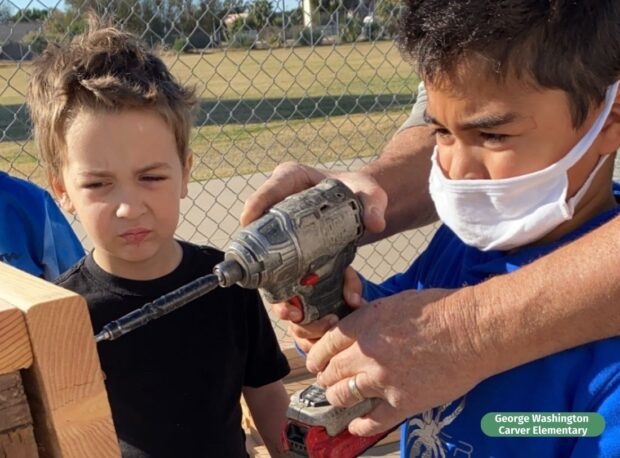We have much more to do and your continued support is needed now more than ever.
Building Gardens, Repurposing Trash and Cleaning Up the Neighborhood

What can 3,100 students and 241 teachers and administrators from 20 schools accomplish when they commit to making changes on their campuses to mitigate climate change? The answer is big things! NWF’s Eco-Green students are using action-based EcoSchools projects to make a difference on their campuses. With the generous support of General Motors, students have designed and built a variety of community gardens that capture rainwater, support community farming, and increase native habitat. Other projects implemented include recycling and compost systems, and even environmentally friendly homes and skateparks.
One of the lessons to come from the last few years is the importance of building meaningful student connections with the environment and the positive benefits of time spent outdoors. School gardens are no longer just for outdoor learning and growing food—they are also places of healing and community connection, as highlighted in Stories from the Eco-Green Schoolyard – A Medium for Healing, Student Learning, and Managing Climate Change. Here are a few more stories.
At Academy of the Americas High School, a Spanish-Immersion school located in SW Detroit, students identified an unused courtyard space adjacent to the front of the school building that could be beautified and utilized as an outdoor learning space. In partnership with GM mentors, students designed and planted a native flower garden, installed two rain barrels, assembled four picnic tables, repurposed an old bike rack for student and staff cyclists, and installed a pathway with walking pavers painted by students. The goals of beautifying the area were to transform these spaces into more inviting, eco-friendly, and usable areas for the school community and allow for stormwater to be absorbed into the garden. Garden stones were also painted with the theme of “celebrating school culture.” Stones were designed into a walking path near the front entrance that was initially just dirt and rocks, which is now a colorful celebration and representation of the school community and one of the first things people see when they walk through the front doors.

Hoover Elementary School in Livonia, Michigan, created plant and pollinator signs to educate students and the larger community as they walk to the campus pollinator garden. Students in all grades researched local pollinators and created colorful signs and a local company generously donated sign. In addition to the colorful pollinator signs, they also created plant identification QR codes linking to student slides telling more about each native plant. Students also created a hummingbird garden in one corner of their outdoor classroom. 3rd & 4th-grade students collaborated to create a chart of plants that would attract hummingbirds with other features they could add to the space. Together, they analyzed the list to make sure that the plants would grow in Michigan, would not be invasive, would be suited to the soil and sun conditions, and then ordered them from a local native plant nursery.

Students at George Washington Carver Elementary School in Yuma, Arizona relocated and rebuilt their vegetable gardens within the school central courtyard to make them more accessible to students and teachers. Students were involved in planting, care, and watering the new beds. Administrators have accomplished the long journey to get the garden certified by the district so that produce grown can be served in the school cafeteria. This year they were able to make two vegetable harvests that were included in the school cafeteria menu.

Hamtramck High School (HHS) in Hamtramck, lead four ‘clean sweeps’ of the school grounds and surrounding neighborhoods. On average, students picked up 8-10 contractor bags of litter each excursion weighing 25 pounds each, keeping nearly 1,000 pounds of trash off the streets. Students at HHS have also been learning about plastic pollution since 9th grade. The class of 2025 decided to encapsulate plastic debris in used water bottles and have built 50 ecobricks. These bricks will become the building material for a water catchment system next school year.

GESU elementary students from 5th through 8th grade met weekly and explored recycling and reducing. Although the meetings were at the school, students also visited the Detroit recycling center and a composting site. After exploring how much garbage the school produces daily, the students focused on cafeteria waste and the abundance of it. The best result from this year was the student’s realization of the amount of waste generated and their suggestions for reducing it. They weighed every bag of garbage over two weeks to discover the school throws away about 100 pounds of garbage a day. Students reduced 12 bags of trash to two after sorting it into recycling, reusables, and compostable, saving 1000 pounds of garbage from the landfill.
Eco-Green sustainability and climate mitigation projects are multifaceted from educating students in STEAM to providing socioemotional learning. These are just five of twenty projects from the 2022-2023 school year that show students, schools and their communities the power of collective impact.
To learn more about Eco-Green, head over to our website or visit the Ecoschools YouTube channel where you will find more stories like these and further information on how to get involved.





















